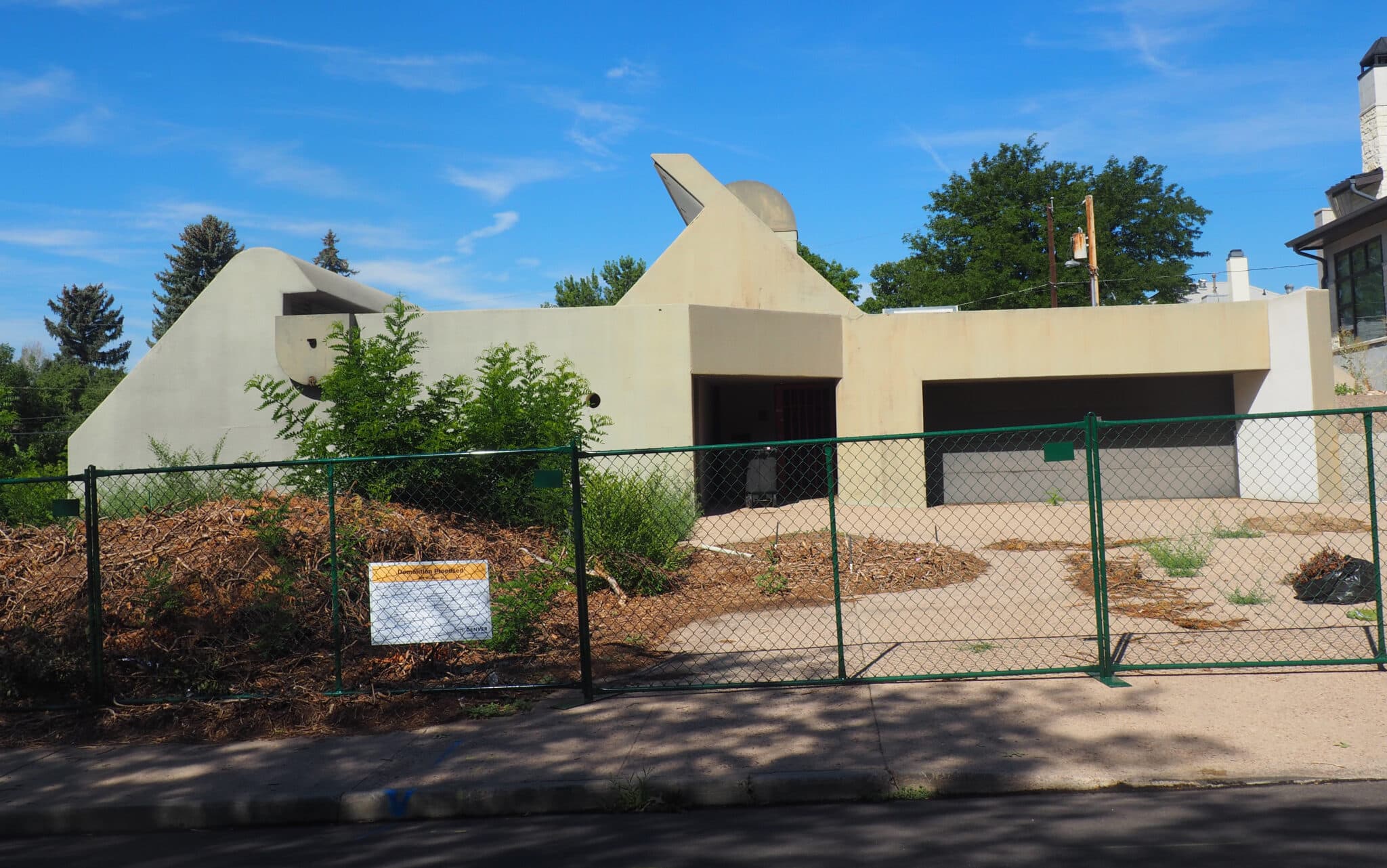
The new owner of the home at 401 N. Madison St. in Cherry Creek is a homebuilder that wants to demolish the home and construct two duplexes on the lot. (BusinessDen file photo)
An effort to save a late architect’s Cherry Creek home from the wrecking ball cleared its first hurdle on Tuesday, even as most members of the public weighing in spoke against preserving the structure.
Denver’s Landmark Preservation Commission voted unanimously Tuesday afternoon to recommend approval of a landmark designation application for the home at 401 N. Madison St., which dates to 1979 and was designed by and for Richard Crowther.
Crowther, who died in 2006, designed elements at Lakeside Amusement Park, buildings for King Soopers and Cooper Cinerama movie theaters, among other things.
The landmark application is opposed by MAG Builders, a Denver-based homebuilder that purchased the home on 0.29 acres in May for $4 million. MAG wants to demolish the structure and build a pair of duplexes, with each unit listing for a multimillion-dollar sum.
MAG applied to the city over the summer for a demolition permit for the structure, which prompted three Denver residents — Tom Hart, Alan Gass and Michael Hughes — to file the landmark application. Designating the structure a city landmark would effectively prevent demolition.

Richard Crowther was known for his energy-conserving architecture. (Photo courtesy of Denver Public Library/Rocky Mountain News)
Hart addressed the landmark commission on Tuesday, describing Crowther as a notable architect and his home as “a significant example of his work,” and an early attempt at energy-saving architecture.
Hart was followed by Steve Gilman, an attorney representing MAG Builders, who described the home as “structurally unsafe,” and questioned how a home with a private indoor swimming pool could represent the broader environmental movement of the 1970s, as a city report had suggested.
Gilman said the home has been vacant since 2007.
“It is clear the neighborhood looks forward to the day when the structure is demolished,” he said.
Gilman’s presentation was followed by comments from members of the public, the bulk of whom indicated they lived within a block or two of the house.
“It can’t be fixed. It’s beyond it,” said a man who lives across the alley from 401 Madison.
“On a regular basis kids are on the roof, rollerblading and skating. I’ve shooed them off a million times,” said a woman who lives in the home to the north.
“I have only seen problems here, nothing else,” said a man who lives across the street.
“My only comment is it seems like there’s more neighborhood opposition than support to this,” said another nearby resident. “That’s all I have to say.”
The preservation effort did have a handful of supporters. A woman on the next block, speaking in support, said her family had owned the home where she lives since 1974, and that it was “annoying” to see neighbors who have only lived in Cherry Creek for a couple years weigh in on what is worth saving.
Another man, attending the meeting virtually, also spoke for preservation, and highlighted that he didn’t live nearby.
“I don’t live in the neighborhood and perhaps that gives me a little bit of perspective,” he said.
In all, 21 letters, 33 signatures and one voicemail were received in opposition to landmark status, according to a city staffer. Five letters were received in support.
When public comment ended, and the commission began deliberations, commission chair Kelly Wemple noted that the body wasn’t supposed to consider the physical condition of the building — just whether it had “historic integrity.”
She noted that the City Council, which will consider the application next, doesn’t have that same restriction.
“We just don’t have the purview,” Wemple said. “But (the) City Council does.”
Commissioner George Dennis, meanwhile, gave a full-throated endorsement of landmark status.
Regarding multiple comments dubbing the building an “eyesore,” Dennis said the same description could be used for “a lot of what’s being built tomorrow.” Regarding a critique that the home’s energy-saving efforts were nothing compared to modern capabilities, he said the building “represents the best of what was known in 1979.”
“I think the Crowther house is one of those that is aching to be saved from the wrecking ball,” Dennis said.
The landmark application now goes to a council committee, which will decide whether or not to send it to the full council for a vote.

The new owner of the home at 401 N. Madison St. in Cherry Creek is a homebuilder that wants to demolish the home and construct two duplexes on the lot. (BusinessDen file photo)
An effort to save a late architect’s Cherry Creek home from the wrecking ball cleared its first hurdle on Tuesday, even as most members of the public weighing in spoke against preserving the structure.
Denver’s Landmark Preservation Commission voted unanimously Tuesday afternoon to recommend approval of a landmark designation application for the home at 401 N. Madison St., which dates to 1979 and was designed by and for Richard Crowther.
Crowther, who died in 2006, designed elements at Lakeside Amusement Park, buildings for King Soopers and Cooper Cinerama movie theaters, among other things.
The landmark application is opposed by MAG Builders, a Denver-based homebuilder that purchased the home on 0.29 acres in May for $4 million. MAG wants to demolish the structure and build a pair of duplexes, with each unit listing for a multimillion-dollar sum.
MAG applied to the city over the summer for a demolition permit for the structure, which prompted three Denver residents — Tom Hart, Alan Gass and Michael Hughes — to file the landmark application. Designating the structure a city landmark would effectively prevent demolition.

Richard Crowther was known for his energy-conserving architecture. (Photo courtesy of Denver Public Library/Rocky Mountain News)
Hart addressed the landmark commission on Tuesday, describing Crowther as a notable architect and his home as “a significant example of his work,” and an early attempt at energy-saving architecture.
Hart was followed by Steve Gilman, an attorney representing MAG Builders, who described the home as “structurally unsafe,” and questioned how a home with a private indoor swimming pool could represent the broader environmental movement of the 1970s, as a city report had suggested.
Gilman said the home has been vacant since 2007.
“It is clear the neighborhood looks forward to the day when the structure is demolished,” he said.
Gilman’s presentation was followed by comments from members of the public, the bulk of whom indicated they lived within a block or two of the house.
“It can’t be fixed. It’s beyond it,” said a man who lives across the alley from 401 Madison.
“On a regular basis kids are on the roof, rollerblading and skating. I’ve shooed them off a million times,” said a woman who lives in the home to the north.
“I have only seen problems here, nothing else,” said a man who lives across the street.
“My only comment is it seems like there’s more neighborhood opposition than support to this,” said another nearby resident. “That’s all I have to say.”
The preservation effort did have a handful of supporters. A woman on the next block, speaking in support, said her family had owned the home where she lives since 1974, and that it was “annoying” to see neighbors who have only lived in Cherry Creek for a couple years weigh in on what is worth saving.
Another man, attending the meeting virtually, also spoke for preservation, and highlighted that he didn’t live nearby.
“I don’t live in the neighborhood and perhaps that gives me a little bit of perspective,” he said.
In all, 21 letters, 33 signatures and one voicemail were received in opposition to landmark status, according to a city staffer. Five letters were received in support.
When public comment ended, and the commission began deliberations, commission chair Kelly Wemple noted that the body wasn’t supposed to consider the physical condition of the building — just whether it had “historic integrity.”
She noted that the City Council, which will consider the application next, doesn’t have that same restriction.
“We just don’t have the purview,” Wemple said. “But (the) City Council does.”
Commissioner George Dennis, meanwhile, gave a full-throated endorsement of landmark status.
Regarding multiple comments dubbing the building an “eyesore,” Dennis said the same description could be used for “a lot of what’s being built tomorrow.” Regarding a critique that the home’s energy-saving efforts were nothing compared to modern capabilities, he said the building “represents the best of what was known in 1979.”
“I think the Crowther house is one of those that is aching to be saved from the wrecking ball,” Dennis said.
The landmark application now goes to a council committee, which will decide whether or not to send it to the full council for a vote.
